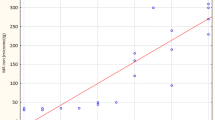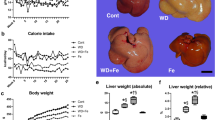Abstract
The role of zinc (Zn) in hepatic steatosis of patients with HCV-related chronic liver disease (CLD-C) remains uncertain, although persistent HCV infection often evokes hepatic steatosis. The primary purpose of this study was to elucidate the contribution of Zn deficiency to hepatic steatosis in patients with CLD-C. Fifty nondiabetic patients with CLD-C were enrolled. Hepatic 4-hydroxy-2-nonenal (4-HNE) expression was examined using an immunohistochemical procedure as a marker for lipid peroxidation. Serum ferritin levels were assessed for iron overload. Insulin resistance was evaluated using the values of the homeostasis model for assessment of insulin resistance (HOMA-IR). The severity of hepatic steatosis was graded on the classification system proposed by Brunt and colleagues. Serum Zn levels were inversely correlated with serum ferritin levels in the patients with CLD-C (r = −0.382, p = 0.0062). Serum ferritin levels were strongly associated with the HOMA-IR values (r = 0.476, p = 0.0005). Therefore, Zn deficiency resulted in insulin resistance through iron overload. Moreover, serum Zn levels were significantly decreased in proportion to the level of hepatic 4-HNE expression, which was enhanced as hepatic steatosis developed. Then, Zn deficiency eventually seemed to exacerbate hepatic steatosis by way of an increase in lipid peroxidation. However, the serum Zn levels were not associated with either loads of HCV-RNA or HCV genotypes. These data suggest that, in patients with CLD-C, Zn deficiency promotes insulin resistance by exacerbating iron overload in the liver and induces hepatic steatosis by facilitating lipid peroxidation.






Similar content being viewed by others
References
Okuda M, Li K, Beard MR, Scholle F et al (2002) Mitochondrial injury, oxidative stress, and antioxidant gene expression are induced by hepatitis C virus core protein. Gastroenterology 122:366–375
Koike K (2005) Hepatitis C as a metabolic disease: implication for the pathogenesis of NASH. Hepatol Res 33:145–150
Negro F, Sanyal AJ (2009) Hepatitis C virus, steatosis and lipid abnormalities: clinical and pathologic data. Liver Int S2:26–37
Kohgo Y, Ikuta K, Ohtake T, Torimoto Y, Kato J (2007) Iron overload and cofactors with special reference to alcohol, hepatitis C virus infection and steatosis/insulin resistance. World J Gastroenterol 13:4699–4706
Shintani Y, Fujie H, Miyoshi H et al (2004) Hepatitis C virus infection and diabetes: direct involvement of the in the development of insulin resistance. Gastroenterology 126:840–848
Poynard T, Ratziu V, McHutchison J et al (2003) Effect of treatment with peginterferon or interferon alpha-2b and ribavirin on steatosis in patients infected with hepatitis C. Hepatology 38:75–85
Romero-Gomez M, Del Mar Viloria M, Andrade RJ et al (2005) Insulin resistance impairs sustained response rate to peginterferon plus ribavirin in chronic hepatitis C patients. Gastroenterology 128:636–641
Lange CM, Kutalik Z, Morikawa K et al (2012) Serum ferritin levels are associated with a distinct phenotype of chronic hepatitis C poorly responding to pegylated interferon-alpha and ribavirin therapy. Hepatology 55:1038–1047
Fartoux L, Poujol-Robert A, Guechot J, Wendum D, Poupon R, Serfaty L (2005) Insulin resistance is a cause of steatosis and fibrosis progression in chronic hepatitis C. Gut 54:1003–1008
Hung CH, Wang JH, Hu TH et al (2010) Insulin resistance is associated with hepatocellular carcinoma in chronic hepatitis C infection. World J Gastroenterol 16:2265–2271
McClain CJ, Kasarskis EJ, Allen JI (1985) Functional consequences of zinc deficiency. Prog Food Nutr Sci 9:185–226
Prasad AS, Boa B, Beck FW, Kucuk O, Sarkar FH (2004) Antioxidant effects of zinc in human. Free Radic Biol Med 37:1182–1190
DiSilvestro RA (2000) Zinc in relation to diabetes and oxidative disease. J Nutr 130:1509S–1511S
Hughes S, Samman S (2006) The effect of zinc supplementation in humans on plasma lipids, antioxidant status and thrombogenesis. J Am Coll Nutr 25:285–291
Mohommad MK, Zou Z, Cave M, Barve A, McClain CJ (2012) Zinc and liver disease. Nutr Clin Pract 27:8–20
Bode JC, Hanisch P, Henning H et al (1988) Hepatic zinc content in patients with various stages of alcoholic liver disease and in patients with chronic active and chronic persistent hepatitis. Hepatology 6:1605–1609
Gimenez A, Pares A, Alie S, Camps J, Deulofeu R, Caballeria J, Rodes J (1994) Fibrogenetic and collagenolytic activity in carbon-tetrachloride-injured rats: beneficial effects of zinc administration. J Hepatol 21:292–298
Baltaci AK, Mogulkoc R, Salbacak A et al (2012) The role of zinc supplementation in the inhibition of tissue damage caused by exposure to electoromagnetic field in rat lung and liver tissues. Bratisl Lek Listy 113:400–403
Himoto T, Hosomi N, Nakai S et al (2007) Efficacy of zinc administration in patients with hepatitis C virus-related chronic liver disease. Scand J Gastroenterol 42:1078–1087
Moriyama M, Matsumura H, Fukushima A et al (2006) Clinical significance of evaluation of serum zinc concentrations in C-viral chronic liver disease. Dig Dis Sci 51:1967–1977
Himoto T, Yoneyama H, Deguchi A et al (2010) Insulin resistance derived from zinc deficiency in non-diabetic patients with chronic hepatitis C. Exp Ther Med 1:707–711
Himoto T, Yoneyama H, Kurokohchi K et al (2011) Selenium deficiency is associated with insulin resistance in patients with hepatitis C virus-related chronic liver disease. Nutr Res 31:829–835
Himoto T, Tani J, Miyoshi H et al (2013) The ratio of insulin-like growth factor-I/insulin-like growth factor-binding protein-3 in sera of patients with hepatitis C virus-related chronic liver disease as a predictive marker of insulin resistance. Nutr Res 33:27–33
Himoto T, Yoneyama H, Kurokohchi K et al (2011) Contribution of zinc deficiency to insulin resistance in patients with primary biliary cirrhosis. Biol Trace Elem Res 144:133–142
Kang X, Zhong W, Liu J, Song Z, McClain CJ, Kang YJ, Zhou Z (2009) Zinc supplementation reverses alcohol-induced steatosis in mice through reactivating hepatocyte nuclear factor-4α peroxisome proliferator-activated receptor-α. Hepatology 50:1241–1250
Lifschits MD, Henkin RI (1971) Circadian variation in copper and zinc in man. J Appl Physiol 31:88–92
Sebastiani G, Vario A, Ferrari A, Pistis R, Noventa F, Alberti A (2006) Hepatic iron, liver steatosis and viral genotypes in patients with chronic hepatitis C. J Viral Hepat 13:199–205
Lau JY, Davis GL, Kinffen J et al (1993) Significance of serum hepatitis C virus RNA levels in chronic hepatitis C. Lancet 341:1501–1504
Sandres-Saue K, Abravanel F, Nicot F et al (2007) Detection and quantitation of HCV RNA using real-time PCR after automated sample processing. J Med Virol 79:1821–1826
Simmonds P, Alberti A, Alter HJ et al (1994) A proposed system for nomenclature of hepatitis C viral genotypes. Hepatology 19:1321–1324
Ichida F, Tsuji T, Omata M et al (1996) New Inuyama classification: new criteria for histological assessment of chronic hepatitis. Int Hepatol Commun 6:112–119
Brunt EM, Janney CG, Bisceglie D (1999) Nonalcoholic steatohepatitis: a proposal for grading and staging the histological lesions. Am J Gastroenterol 94:2467–2474
Kassab-Chekir A, Laradi S, Ferchichi S et al (2003) Oxidant, antioxidant status and metabolic data in patients with beta-thalassemia. Clin Chim Acta 338:79–86
Dehshal MH, Hooghooghi AH, Kebryaeezadeh A et al (2007) Zinc deficiency aggravates abnormal glucose metabolism in thalassemia major patients. Med Sci Monit 13:CR235–CR239
Delima R, Trinder D, Olynyk K (2007) Potential protective effects of zinc in iron overload. Liver Int 27:4–5
Liuzzi JP, Aydemir F, Nam H, Knutson MD, Cousins RJ (2006) Zip14 (Slc39a14) mediates non-transferrin-bound iron uptake into cells. Proc Natl Acad Sci U S A 103:13612–13617
Mendler MH, Turlin B, Moirand R et al (1999) Insulin resistance-associated hepatic iron overload. Gastroenterology 117:1155–1163
McNall AD, Etherton TD, Fosmire GJ (1995) The impaired growth induced by zinc deficiency in rats is associated with decreased expression of hepatic insulin-like growth factor-I and growth hormone receptor genes. J Nutr 125:874–879
Mikhail TH, Nicola WG, Ibrahim KH, Salama SH, Emam M (1996) Abnormal zinc and copper metabolism in hepatic steatosis. Boll Chim Farmaceuticol 135:591–597
Shaheen AA, el-Fattah AA (1995) Effect of dietary zinc on lipid peroxidation, glutathione, protein thiols levels and superoxide dismutase activity in rat tissues. Int J Biochem Cell Biol 27:89–95
Ozturk A, Baltaci AK, Mogulkoc R et al (2003) Effects of zinc deficiency and supplementation on malondialdehyde and glutathione levels in blood and tissues of rat performing swimming exercise. Biol Trace Elem 94:157–166
Bao B, Prasad AS, Beck FW et al (2010) Zinc decreases C-reactive protein, lipid peroxidation, and inflammatory cytokines in elderly subjects: a potential implication of zinc as an atheroprotective agent. Am J Clin Nutr 91:1634–1641
Crabb DW, Galli A, Fisher M, You M (2004) Molecular mechanisms of alcoholic fatty liver: role of peroxisome proliferator-activated receptor alpha. Alcohol 34:35–38
Reiterer G, Toborek M, Hennig B (2004) Peroxisome proliferator activated receptor alpha and gamma require zinc for their anti-inflammatory properties in porcine vascular endothelial cells. J Nutr 134:1711–1715
Zhong W, Zhao Y, Sun X, Song Z, McClain CJ, Zhou Z (2013) Dietary zinc deficiency exaggerated ethanol-induced liver injury in mice: involvement of intrahepatic and extrahepatic factors. PLoS One 8(e76522):1–10
Fletcher LM, Roberts FD, Irving MG, Powell LW, Halliday JW (1989) Effects of iron loading on radical scavenging enzymes and lipid peroxidation in rat liver. Gastroenterology 97:1011–1018
MacDonald GA, Bridle KR, Ward PJ et al (2001) Lipid peroxidation in hepatic steatosis in human is associated with hepatic fibrosis and occurs predominately in acinor zone 3. J Gastroenterol Hepatol 16:599–606
Farinati F, Cardin R, De Maria N et al (1995) Iron storage, lipid peroxidation and glutathione turn over in chronic anti-HCV positive hepatitis. J Hepatol 22:449–456
Author information
Authors and Affiliations
Corresponding author
Rights and permissions
About this article
Cite this article
Himoto, T., Nomura, T., Tani, J. et al. Exacerbation of Insulin Resistance and Hepatic Steatosis Deriving from Zinc Deficiency in Patients with HCV-Related Chronic Liver Disease. Biol Trace Elem Res 163, 81–88 (2015). https://doi.org/10.1007/s12011-014-0177-3
Received:
Accepted:
Published:
Issue Date:
DOI: https://doi.org/10.1007/s12011-014-0177-3




